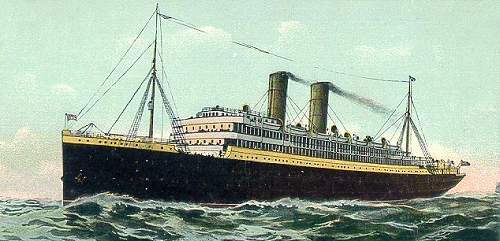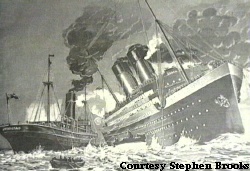The Empress of Ireland, sometimes referred to as ‘Canada’s Titanic’ was responsible for carrying 918 British Home Children to Canada between 1906 and 1914. Of the larger organizations, the Fegan Homes sent 436 children on the Empress and Mrs. Birt of the Liverpool Sheltering Homes brought 69. According to Canada’s Library and Archives database, some Home children travelled alone or in small groups with no apparent escort. The children had destinations anywhere between New Brunswick and British Columbia.
Eleven British Home Children were on the last incoming voyage of the Empress in 1914. Just seven days later, in the early hours of May 29.1914, she sank in the cold waters of the Saint Lawrence River in just fourteen minutes on her way to Liverpool from Quebec. Of the 1477 passengers and crew onboard the Empress, about 70 percent were lost at sea. The total deaths surpassed any other Canadian Marine accident during peacetime.
Of the 217 passengers who survived was G. Bogue Smart, Inspector of British Immigrant Children and Receiving Homes, who was on his way to England to bring back a group of Home Children. As in the Titanic disaster, more first class passengers survived than second or third.
Built in Glasgow, Scotland, the Empress was owned by Canadian Pacific Steamships (part of Canadian Pacific Railways). She was launched in 1906 and provided four classes of accommodation. On her maiden voyage she was considered both fast and reliable.
On her last voyage, she left Quebec City at about 16:30 on the 28th of May, under the hands of Captain Henry Kendall, who had just been promoted and was on his first trip down the Saint Lawrence in command of her. The ship reached Rimouski in the early hours of the morning on the 29th and a Norwegian collier, the Storstad, was sighted. However, fog soon rolled in and the ships lost visibility. They had to resort to fog whistles.  At about 02:00 local time the Storstad crashed into Empress’ starboard side. The Empress immediately began flooding and listed to starboard. There was no time to shut the watertight doors. Those on the lower decks drowned quickly as the water rushed in. Those on the upper decks were woken up by the collision but there was only time to fill some lifeboats. Ten minutes after the collision, the ship lurched to starboard, allowing some passengers and crew to climb out of portholes on the port side. This reprieve lasted only a minute or two until the stern rose out of the water and the ship sank, throwing those who had crawled out into the freezing water. There was no time to think or act. In comparison, the Titanic sank in two hours and forty minutes.
At about 02:00 local time the Storstad crashed into Empress’ starboard side. The Empress immediately began flooding and listed to starboard. There was no time to shut the watertight doors. Those on the lower decks drowned quickly as the water rushed in. Those on the upper decks were woken up by the collision but there was only time to fill some lifeboats. Ten minutes after the collision, the ship lurched to starboard, allowing some passengers and crew to climb out of portholes on the port side. This reprieve lasted only a minute or two until the stern rose out of the water and the ship sank, throwing those who had crawled out into the freezing water. There was no time to think or act. In comparison, the Titanic sank in two hours and forty minutes.

The Storstad and boats from nearby villages rescued survivors in the darkness, but hundreds died in the frigid water. Those who were alive were clothed and sheltered by the villagers. Only four of the 138 children aboard the Empress survived and the remains of hundreds of people are still entombed in her wreck. Days after the accident, searchers recovered bodies from the river, though many of the dead could not be identified and have been buried in Rimouski. Soon, family members from across Canada began to arrive to claim their loved ones. The Salvation Army, which had dispatched 170 of its members on the ship to a rally in England, lost 141 of its members. Since then, an annual remembrance ceremony is held at Toronto’s Mount Pleasant Cemetery.
As the reports of the two captains conflicted as to who was at fault, Lord Mersey, who had presided over the inquiry of the Titanic, headed this inquiry. Convened in Quebec City on June 16, 1914, the Storstad was found to be at fault. The Norwegian Consulate General in Montreal also held an inquiry and exonerated the ship and its captain, Thomas Andersen. Andersen claimed the Empress caused the collision by turning northwest into the path of the collier. The two conclusions are irreconcilable. Both captains went on to serve in the First World War.
Three incidents happened that had the superstitious shaking their heads. The first was that the Empress’ sister ship had been rammed by a Norwegian collier ship near the same spot two years prior. The second was that the ship’s cat ran away from the ship, was caught and ran away again – a sailor’s sure sign of a bad omen. The third was that one of the crew members who survived was William Clark. He had also survived the Titanic.
The Empress of Ireland still lies beneath the waters of the St. Lawrence and many divers have plundered her over the years. However, in 1999 the wreck was declared a site of historical and archaeological importance and is protected under the Cultural Property Act and listed in the register of Historic Sites of Canada.This was the first time that an underwater site had received this status in Quebec.
